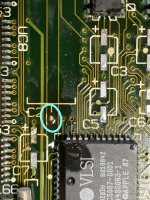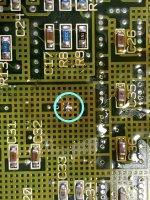I am recapping one of my SE/30s and I am having lots of trouble removing solder from one of the through holes for one of the axial caps. I've done 3 of the holes fine (4 in total, 2 each for 2 caps), but the last one just wants to be difficult - there is a really small piece of the old capacitor lead stuck in-between the board, and heating the solder from either side and trying to push it through is not working. Using desoldering wick and tons of flux is also not working, perhaps my desoldering wick is a bit too chunky for this size hole to pick up all the solder? I tried a smaller solder tip and tried pushing it through the hole, again no good. I also tried with a hot air gun but again still couldnt get it to push through. I've tried using tweezers while the joint is heated to pull or poke through - again not happening.
Any finally, I tried my solder sucker after adding new solder hoping it would just suck it all up, but alas it sucks it up to the point I've got in the photos below...
I am at the point where I think my only option is to drill it out, however I don't have a small enough drill bit for this so I would have to buy one...
See photos attached to see what I'm dealing with...any ideas?


Any finally, I tried my solder sucker after adding new solder hoping it would just suck it all up, but alas it sucks it up to the point I've got in the photos below...
I am at the point where I think my only option is to drill it out, however I don't have a small enough drill bit for this so I would have to buy one...
See photos attached to see what I'm dealing with...any ideas?



